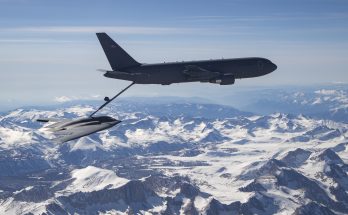by Derek Bisaccio, Military Markets Analyst, Forecast International.

Source: Venezuela Ministry of Defense
Throughout the month of September, Venezuela saw a flare-up in hostility with two of its neighbors, Colombia and Guyana, over separate issues. The diplomatic rows with Colombia appear to have subsided for now, following meetings between the presidents of the two countries. The tensions with Guyana, however, continue to simmer.
Venezuela and Guyana have had a long-standing dispute over ownership of the Essequibo region of Guyana. The disagreement dates to an 1899 ruling that gave much of the Essequibo to British Guiana, which was at that point still a colony of the United Kingdom, while ceding some land to Venezuela. Caracas formally raised its objection to the ruling in 1962 at the United Nations, declaring that the ruling was invalid and that Venezuela was owed all of the land west of the Essequibo River as well as waters off its coast. Though the issue had largely remained dormant for decades since, the discovery of sizeable reserves of oil in the disputed territory and offshore waters has recently raised the stakes.
Following announcements of large reserves of oil off the coast of nearby French Guyana, oil companies grew increasingly interested in exploring the coast of Guyana for additional reserves. In 2013, the Venezuelan Navy detained an exploration vessel that was operating in disputed waters with the blessing of Georgetown,[1] on the basis that it did not have permission from Caracas to operate in the area. Almost two years later, in May 2015, ExxonMobil Corporation announced its discovery of offshore reserves in the Stabroek Block,[2] which is claimed by both Venezuela and Guyana. Venezuela demanded that Exxon cease its activities in the waters, and in July, President Nicolas Maduro recalled the Venezuelan ambassador to Guyana.[3] Venezuela also unilaterally extended its maritime boundary and established an Atlantic Maritime Integral Defense Zone that includes portions of the disputed territory.
The situation deteriorated further in September, seemingly in response to comments by Guyanese President David Granger that if bilateral discussions over Essequibo failed to produce results, he would take the matter to the United Nations.[4] Soon after, Granger claimed there was “an extraordinary escalation of Venezuelan military activity in eastern Venezuela.”[5] Venezuela, seemingly retroactively, announced that the military activity was in the form of operational exercises. In response, Guyana has conducted military exercises of its own.[6]
Venezuela’s political standoff with Guyana is likely at least a partial driver in the former’s recent procurement pushes, though Venezuela does have much larger armed forces than its neighbor to the east (and Venezuela has other issues, including fighting narcotics trafficking, that necessitate procurements). In 2014, Venezuela signed an agreement with Damen Group for 38 naval vessels.[7] Many of these are patrol ships that will help Venezuela cover its newly established defense zone. Shortly after one of its Su-30MKs crashed in anti-narcotics operations near the border with Colombia, Venezuela announced its intention to purchase at least 12 of the aircraft from Russia, despite the fact that it currently possesses 23 Su-30s.
The new aircraft purchase seems to have spooked Guyana, which announced that it is considering procuring new military aircraft for its Air Corps.[8] Following through on this announcement, however, would be a significant development for the country. Guyana has a tiny defense budget – Georgetown likely spent no more than $37.6 million total in 2015 on defense,[9] which includes personnel costs – so purchasing aircraft would require assistance in financing. This is likely to blunt any efforts to procure new aircraft. Chief of Staff of the Guyana Defense Force Mark Phillips stated that such a purchase would only be approved after an analysis of threats to Guyana, which would take Guyana’s limited budget into account. Moving forward with a purchase of, or even a search for, new aircraft would give an indication of just how seriously the country views its situation with Venezuela.
The 2013 seizure of the exploration boat and saber rattling notwithstanding, the showdown over Essequibo has largely remained peaceful. Several days prior to addressing the United Nations General Assembly in September, Maduro and Granger announced diplomatic relations will resume and a U.N. special committee will travel to Venezuela to assess Caracas’ claims to Essequibo.[10] Maduro emphasized that the two countries should have permanent bilateral communication over the topic.
Even so, Guyana appears determined to bring international arbitration into the dispute – where it would be likely to succeed – should bilateral discussions prove unsuccessful. In his speech at the U.N. General Assembly, Granger accused Venezuela of “destabilizing a stable region of the globe by the use of armed force against a peaceful, small state.” He further called for “a juridical settlement to this controversy.”[11] Given the amount of oil reserves on the line – up to 700 million barrels[12] – Guyana is likely to move forward by all means possible to resolve the issue with Venezuela so that it can begin building infrastructure to exploit the oil.
[1] BBC News, “US ship detained by Venezuela in Guyana disputed waters,” October 12, 2013. http://www.bbc.com/news/world-latin-america-24500362
[2] Neil Marks, “Guyana says Exxon discovers oil in offshore block,” Reuters, May 7, 2015. http://www.reuters.com/article/2015/05/07/guyana-exxon-mobil-idUSL1N0XY28X20150507
[3] Brian Ellsworth and Lisa Shumaker, “Venezuela recalls ambassador to Guyana amid territory dispute,” Reuters, July 6, 2015. http://www.reuters.com/article/2015/07/07/us-venezuela-guyana-idUSKCN0PH04P20150707
[4] El Universal, “Guyana to seek at the UN solution to dispute over the Essequibo region,” September 18, 2015. http://www.eluniversal.com/nacional-y-politica/150918/guyana-to-seek-at-the-un-solution-to-dispute-over-the-essequibo-region
[5] MercoPress, “Guyana claims Venezuela is making ‘abnormal military deployments’ near the border,” September 23, 2015. http://en.mercopress.com/2015/09/23/guyana-claims-venezuela-is-making-abnormal-military-deployments-near-the-border
[6] El Universal, “Guyana began military exercises on Friday,” September 25, 2015. http://www.eluniversal.com/nacional-y-politica/150925/guyana-began-military-exercises-on-friday
[7] Info Defensa, “Damen iniciará la construcción de 38 embarcaciones para Venezuela,” April 14, 2014. http://www.infodefensa.com/latam/2014/04/14/noticia-damen-inicara-construccion-unidades-navales-venezuela.html?aleat=3735
[8] El Universal, “Guyana ponders procurement of new combat aircraft for Air Corps,” September 28, 2015. http://www.eluniversal.com/nacional-y-politica/150928/guyana-ponders-procurement-of-new-combat-aircraft-for-air-corps
[9] This figure is calculated using data from the Stockholm International Peace Research Institute (SIPRI) and the IMF World Economic Outlook database. SIPRI figures indicate that Guyana’s defense expenditures have recently amounted to 1.2% of GDP; the IMF projects Guyana’s GDP in 2015 to be $3.147 billion.
[10] El Universal, “UN committee to visit Venezuela to assess claim over the Essequibo,” September 27, 2015. http://www.eluniversal.com/nacional-y-politica/150927/un-committee-to-visit-venezuela-to-assess-claim-over-the-essequibo
[11] David Granger, “The security of small states in the international system,” September 29, 2015. http://gadebate.un.org/sites/default/files/gastatements/70/70_GY_en.pdf
[12] Bloomberg News, “Exxon’s Guyana Oil Discovery May Be 12 Times Larger Than Economy,” July 21, 2015. http://www.bloomberg.com/news/articles/2015-07-21/exxon-s-guyana-oil-find-may-be-worth-12-times-the-nation-s-gdp
For 50 years, Forecast International intelligence reports have been the aerospace and defense industry standard for accurate research, analysis, and projections. Our experienced analysts compile, evaluate, and present accurate data for decision makers. FI's market research reports offer concise analysis of individual programs and identify market opportunities. Each report includes a program overview, detailed statistics, recent developments and a competitive analysis, culminating in production forecasts spanning 10 or 15 years. Let our market intelligence reports be a key part of reducing uncertainties and mastering your specific market and its growth potential. Find out more at www.forecastinternational.com




